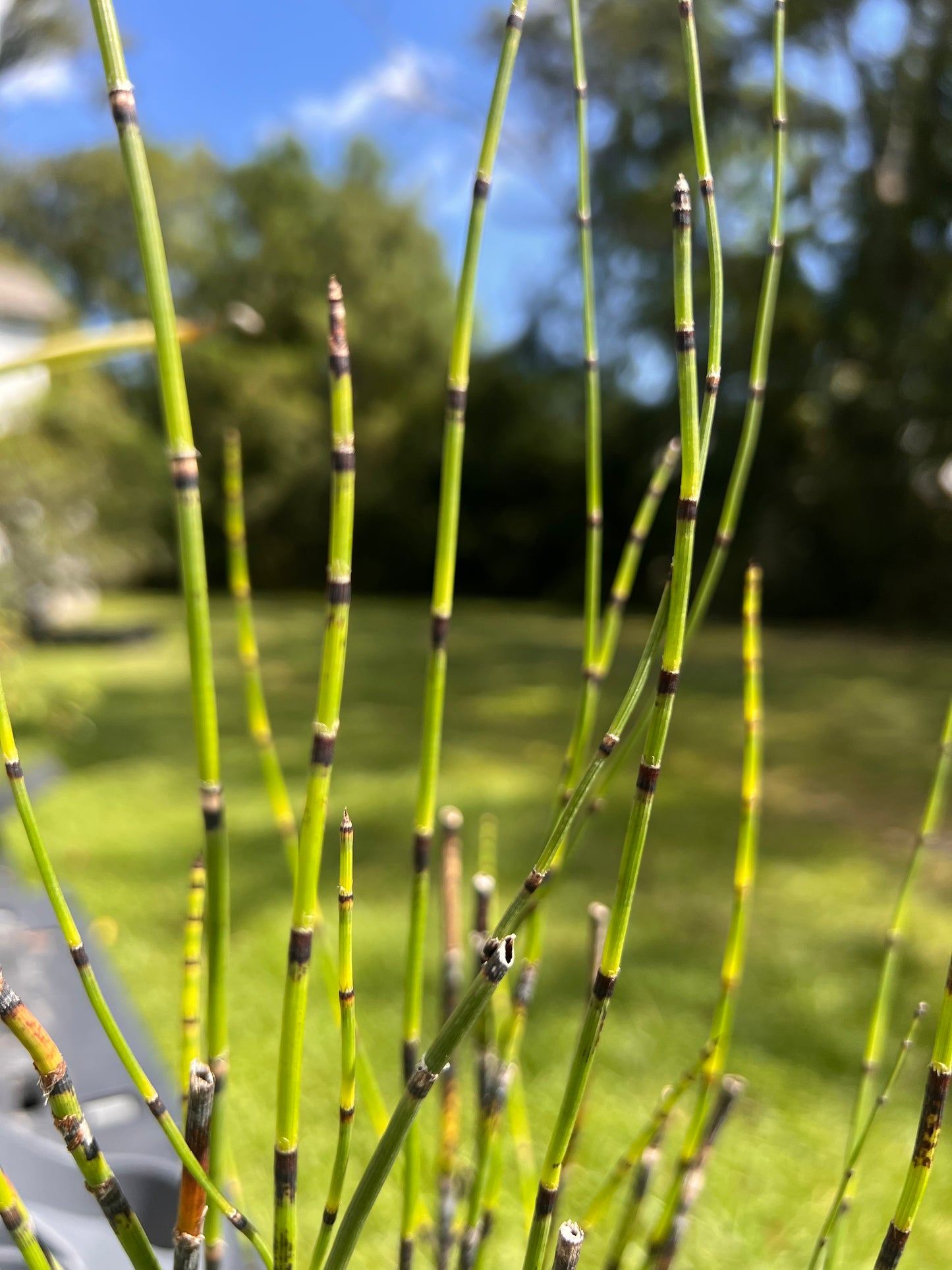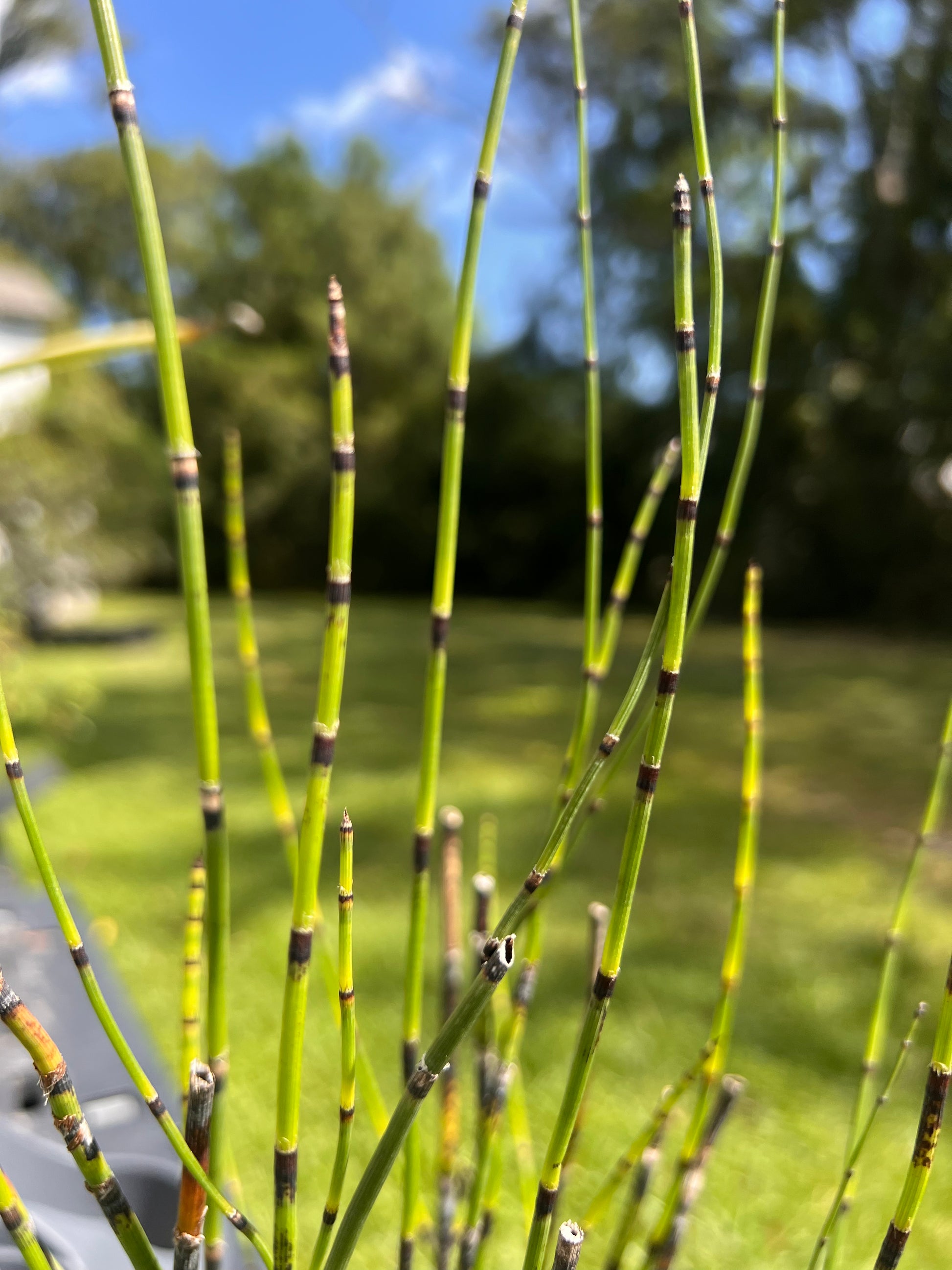Equisetum hyemale 'Horse Tail Reed '
Equisetum hyemale 'Horse Tail Reed '
Horsetail Reed (Equisetum hyemale), also known as Scouring Rush, is a distinctive, perennial plant with a unique, reed-like appearance. It is characterized by its tall, hollow, green stems, which are jointed with black rings at each segment. The stems are unbranched and have a rough texture due to the presence of silica, which gives them a slightly abrasive feel. This plant has no true leaves, and its vertical, cylindrical growth makes it a striking feature in both natural and ornamental settings. Horsetail Reed is known for its aggressive growth and can spread rapidly under the right conditions.
Grow Zone
Horsetail Reed is hardy in USDA zones 4-9. It can tolerate a wide range of climates, from cold temperate to warm, humid regions.
Height and Width
- Height: Horsetail Reed typically grows to a height of 2 to 5 feet (60 to 150 cm), depending on the growing conditions.
- Width: The plant spreads through rhizomes and can form dense colonies, with the spread varying widely depending on containment and control measures. It can cover large areas if left unchecked.
Uses
Horsetail Reed has both ornamental and practical applications:
- Ornamental: Its vertical, architectural form makes it an excellent choice for modern, minimalist, or water gardens. It can be used as a dramatic accent plant, in containers, or as a backdrop in mixed plantings.
- Water Gardens: Horsetail Reed thrives in wet conditions, making it ideal for planting along the edges of ponds, streams, or in bog gardens.
- Erosion Control: Its dense, spreading growth habit makes it useful for stabilizing soil on slopes or in areas prone to erosion.
- Crafts and Traditional Uses: Historically, Horsetail Reed was used for scouring and polishing due to its high silica content. It is still occasionally used in traditional crafts.
- Medicinal: In some cultures, Horsetail has been used in herbal medicine, particularly for its diuretic properties. However, it should be used with caution as it can be toxic in large quantities.
Native Range
Horsetail Reed is native to a broad range across the Northern Hemisphere, including North America, Europe, and Asia. It typically grows in wet habitats such as marshes, riverbanks, and moist woodlands.
How to Grow Horsetail Reed
1. Planting Time:
- Plant in the spring or early summer when the soil is warm and the risk of frost has passed.
- It can also be planted in early fall in milder climates.
2. Soil Preparation:
- Horsetail Reed thrives in wet, poorly-drained soils, and can tolerate standing water.
- It prefers acidic to neutral soil (pH 6.0-7.0) but can adapt to a range of soil types, including clay and sandy soils.
3. Planting:
- If planting directly in the ground, consider using a root barrier or planting it in a container submerged in the ground to prevent aggressive spreading.
- Space plants 1 to 2 feet apart if planting multiple specimens.
- If planting in a water garden, submerge the container so that the water covers the top of the soil by about 1 to 2 inches.
4. Watering:
- Keep the soil consistently moist; Horsetail Reed prefers wet conditions and can tolerate standing water.
- In drier areas, ensure the soil does not dry out, especially during the growing season.
5. Sunlight:
- Horsetail Reed grows well in full sun to partial shade.
- In hotter climates, it may benefit from some afternoon shade to prevent the stems from drying out.
6. Fertilization
- Fertilization is generally not necessary, as Horsetail Reed is capable of thriving in poor soils.
- If desired, apply a balanced, slow-release fertilizer in the spring to encourage robust growth.
7. Pruning and Maintenance:
- Trim back old or dead stems in late winter or early spring to make way for new growth.
- Regularly monitor the plant to control its spread, especially if planted in a garden bed or near sensitive areas.
8. Propagation:
- Horsetail Reed is most easily propagated by division of the rhizomes.
9. Pest and Disease Management:
- Horsetail Reed is generally pest and disease resistant.
- Ensure good water quality in water gardens to prevent any potential issues with algae or bacterial growth.
Horsetail Reed is a striking, low-maintenance plant that adds vertical interest and texture to gardens, particularly in wet or boggy areas. Its unique appearance and adaptability make it a favorite for those looking to create a natural or contemporary landscape.
---SHIPPING NOTICE PLEASE READ BEFORE PURCHASING LIVE PLANTS!---
We WILL NOT refund the purchase of or the shipping cost of live plants purchased with the intent to be shipped to states that do not authorize importing live plants or to states with restrictions! Purchases to these states will be held for 30 days for pick-up at our Slidell, Louisiana store and the shipping cost associated with these purchases will be held for the care of the plant while waiting to be picked up. All sales are final. If the plant(s) purchased are not picked up within 30 days from the date of order, these items will be returned to our sales inventory and you WILL NOT be refunded. Thank you for understanding these policies.
Due to regulations, certain states have restrictions on importing plants. Please review the list below to ensure you're not attempting to order any restricted plants in your area.
**Important Note:** We do not ship any plants outside the U.S.
State-Specific Restrictions - We ARE NOT responsible for any plant(s) that are not listed in these restrictions. Purchaser bears all responsibility for making sure the plant(s) they desire to purchase are not banned from being imported to the shipping state:
Arizona: Juglans spp.
California: Castanea spp., Juglans spp., Pinus spp., Quercus spp.
Colorado: Some counties restrict Prunus spp. Please verify your local county regulations.
Florida: Castanea spp., Cornus spp., Quercus spp., Cornus mas
Georgia: Vaccinium spp.
Hawaii: Pinus spp.
Idaho: Humulus lupulus, Mentha spp., Vitis spp.
Indiana: Fragraria spp., Rosa spp.
Kansas: Juglans spp.
Michigan: Abies spp., Vaccinium spp.
Montana: Pinus spp.
Nevada: Allium spp.
, Mentha spp.
New Jersey: Rosa spp.
New York: Vitis spp.
Oregon: Allium spp., Castanea spp., Corylus spp., Humulus lupulus, Quercus spp., Sambucus nigra, Ulmus spp., Vaccinium spp., Vitis spp.
Texas: Juglans spp.
Washington: Allium spp., Castanea spp., Corylus spp., Humulus lupulus, Vaccinium spp., Vitis spp.
Wisconsin: Abies spp., Pinus spp., Picea spp., Mentha spp.
Additionally, we cannot ship plants in soil medium to the following states: AK, AL, AR, AZ, CA, HI, ID, KS, MS, MT, ND, NM, NV, OK, OR, SD, TX, UT, WA.
Couldn't load pickup availability


